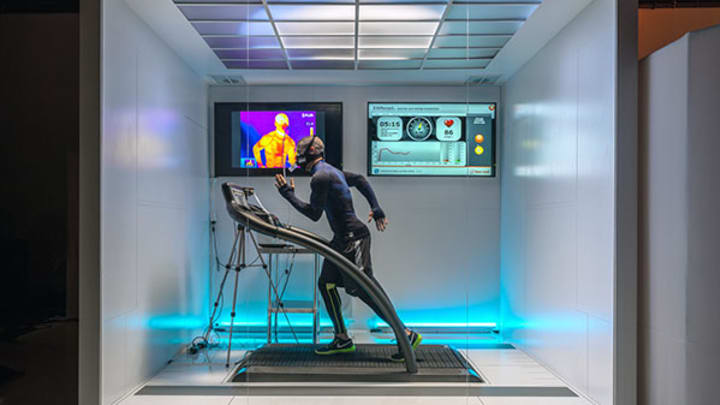Nike's HyperSchool is in Session!

Last week, Nike invited Sports Illustrated Kids to HyperSchool, a fun and interactive experience, to teach us how weather impacts athletes. With a recreated classroom (chalkboard, desks, bulletin boards, and bespectacled teacher to boot) and a makeshift research lab, HyperSchool also highlighted the science behind the company’s pro combat baselayer apparel.
Our classmates were pretty cool, too. HyperSchool’s star athlete, err, student, Atlanta Falcons running back Steven Jackson, joined us in discussing gridiron action and braving the elements. We also met Hal, a copper-sweating mannequin who helps Nike scientists develop active wear.
There was lots to cover during our school session. We made sure to pay careful attention and take diligent notes to share some of the innovative ways Nike is helping athletes to bring their A game even in the most extreme weather conditions.
More than half of the NFL will play in extreme weather
This season, two-thirds of NFL teams will compete in extreme weather conditions. That means they’ll play in temperatures higher than 80 degrees or below 32 degrees Fahrenheit. Add rain, sleet, snow, and wind, and all of a sudden NFL players have to combat opponents and environmental factors.
At HyperSchool, we reviewed each team’s home and away schedules, along with weather predictions. We learned the Seattle Seahawks have the mildest weather schedule, while the Miami Dolphins have the hottest. Can you guess which pro team has the coldest? Yup, the Green Bay Packers. They’re impacted by frigid home-field temps thanks in part to its neighbor, Lake Michigan. Hopefully, those cheeseheads keep the Lambeau faithful warm.
Click the image for a larger version!
For Jackson, playing in the northwest and Midwest can be challenging. He says his baselayer apparel helps keeps his body temp regulated no matter the weather — and that helps him keep his mind on the game.
“The weather in Chicago and Seattle can make playing conditions tough. That wind in Chicago and the rain in Seattle, each are my nemesis,” Jackson said in between classes at HyperSchool. “But Nike has developed some really good products that helps me focus on my job on the field.”
Jackson ditches long sleeves in chilly temps
An 11-year NFL veteran, Jackson has played eight years longer than the average pro running back. (There’s not much longevity in the position. The average career length is only 3.4 years). So he’s developed a feel for the game over the years and is particular about his approach in rushing for a touchdown, no matter the weather conditions.
Jackson stressed the importance of having a first layer that will keep you warm but won’t allow you to overheat. But even in chilly weather, he prefers to be sleeveless on the field. “I like the feeling of the ball against my skin,” said Jackson, who has rushed for career 64 TDs.
And this being football, pads are just as important as what players wear over them. This is especially true for running backs. On average, they take the most hits on the field, according to Nike data. So Jackson relies on lightweight and flexible pads for breathable protection when the defense is after him. Nike sports scientists use a special pressure-sensing technology to design a padding system that helps Jackson play at an elite level.
Meet Hal, the moving mannequin that sweats
But the use of cutting-edge tech doesn’t end there. Nike also relies on Hal, a souped-up mannequin to help develop its products. During HyperSchool, SI Kids met and watched Hal in motion. He’s life-sized, wired, and made of copper. He also sweats.
Hal usually lives in a temperature-controlled room at Nike’s home base in Beaverton, Oregon. But he was brought to New York to demonstrate how Nike scientists use Hal to test out the company’s gear: First, they fill Hal up with water. This allows him to “sweat.” Then they dress him in all sorts of Nike apparel and turn up or turn down temperatures to see how what he’s wearing reacts to his sweat and movements.
Sure, it’s best to use actual athletes for apparel testing. But it’s also time-consuming for them. So, that’s where Hal comes in as a great sub.
We wonder if he’d be a great substitute teacher too. Hmm.
Photos courtesy Nike



